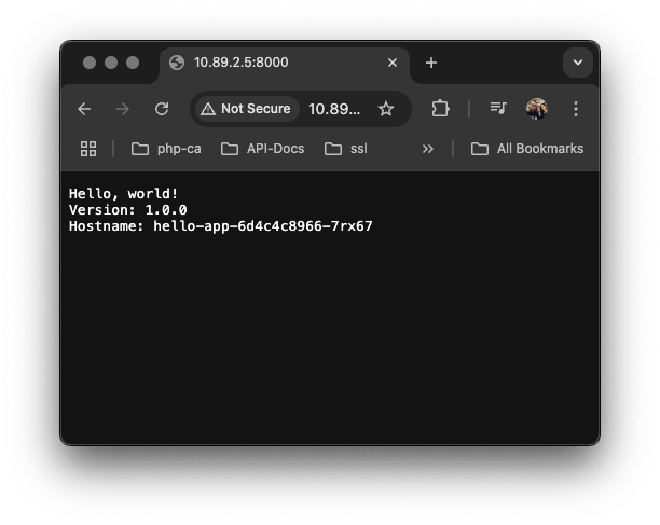Introduction#
Kubernetes has become the de facto standard for container orchestration. However, for many developers, the concepts of deployments and services can be confusing at first.
Basic Concepts#
Deployment#
A deployment in Kubernetes is a set of instructions that defines how a group of pods should be created, run, and maintained within the cluster.
Essentially, it is the way you can tell the cluster:
I want my application to always be available, with a specific number of replicas.
Features#
- Automatic failure handling (restart of failed pods)
- Horizontal scalability (more replicas as demand increases)
- Stabilty (rolling updates1 and rollbacks2)
Service#
When a deployment is used to dynamically create, delete, or replace pods, there is no straightforward way to know how many pods are active or how many are in a healthy state. This is why services become a powerful tool for exposing an application running across one or more pods in a cluster, even when those pods are running on different nodes.
Creating a Deployment#
Next, we will create a deployment named hello-app-deployment, which will be configured to start a single pod consisting of a container running Google’s hello-app image. We will also define CPU and RAM limits, as well as expose port 8080 on each pod.
We create a file named hello-app-deployment.yaml with the following content:
apiVersion: apps/v1
kind: Deployment
metadata:
name: hello-app-deployment
labels:
app: hello
spec:
replicas: 1
selector:
matchLabels:
app: hello
template:
metadata:
labels:
app: hello
spec:
containers:
- name: hello-app
image: us-docker.pkg.dev/google-samples/containers/gke/hello-app:1.0
ports:
- containerPort: 8080
resources:
requests:
cpu: "250m"
memory: "64Mi"
limits:
cpu: "250m"
memory: "128Mi"
1apiVersion: apps/v1
2kind: Deployment
3metadata:
4 name: hello-app-deployment
5 labels:
6 app: hello
7spec:
8 replicas: 1
9 selector:
10 matchLabels:
11 app: hello
12 template:
13 metadata:
14 labels:
15 app: hello
16 spec:
17 containers:
18 - name: hello-app
19 image: gcr.io/google-samples/hello-app:1.0
20 ports:
21 - containerPort: 8080
22 resources:
23 requests:
24 cpu: "250m"
25 memory: "64Mi"
26 limits:
27 cpu: "250m"
28 memory: "128Mi"Apply the changes
# kubectl apply -f hello-app-deployment.yaml
deployment.apps/hello-app-deployment createdCheck the status of the deployment
# kubectl get deployments
NAME READY UP-TO-DATE AVAILABLE AGE
hello-app-deployment 1/1 1 1 30mREADY column, we can see that the number of replicas is 1.We can also get detailed information about the deployment using the describe command
# kubectl describe deployment hello-app-deployment
Name: hello-app-deployment
Namespace: default
CreationTimestamp: Wed, 04 Jun 2025 18:07:05 -0500
Labels: app=hello
Annotations: deployment.kubernetes.io/revision: 1
Selector: app=hello
Replicas: 1 desired | 1 updated | 1 total | 1 available | 0 unavailable
StrategyType: RollingUpdate
MinReadySeconds: 0
RollingUpdateStrategy: 25% max unavailable, 25% max surge
Pod Template:
Labels: app=hello
Containers:
hello-app:
Image: us-docker.pkg.dev/google-samples/containers/gke/hello-app:1.0
Port: 8080/TCP
Host Port: 0/TCP
Limits:
CPU: 250m
memory: 128Mi
Requests:
CPU: 250m
memory: 64Mi
Environment: <none>
Mounts: <none>
Volumes: <none>
Node-Selectors: <none>
Tolerations: <none>
Conditions:
Type Status Reason
---- ------ ------
Progressing True NewReplicaSetAvailable
Available True MinimumReplicasAvailable
OldReplicaSets: <none>
NewReplicaSet: hello-app-6d4c4c8966 (1/1 replicas created)
Events: <none>Let’s slightly modify the file hello-app-deployment.yaml to increase the number of replicas to 3.
1apiVersion: apps/v1
2kind: Deployment
3metadata:
4 name: hello-app-deployment
5 labels:
6 app: hello
7spec:
8 selector:
9 matchLabels:
10 app: hello
11 template:
12 metadata:
13 labels:
14 app: hello
15 spec:
16 replicas: 3
17 containers:
18 - name: hello-app
19 image: gcr.io/google-samples/hello-app:1.0
20 ports:
21 - containerPort: 8080
22 resources:
23 requests:
24 CPU: "250m"
25 memory: "64Mi"
26 limits:
27 CPU: "250m"
28 memory: "128Mi"Apply the changes
# kubectl apply -f hello-app-deployment.yaml
deployment.apps/hello-app-deployment configuredCheck the status of the deployment.
As we can see, the value in the READY column changed from 1/1 to 3/3.
# kubectl get deployments
NAME READY UP-TO-DATE AVAILABLE AGE
hello-app 3/3 3 3 44mWe can also see the created pods
# kubectl get pods
NAME READY STATUS RESTARTS AGE
hello-app-deployment-6d4c4c8966-7rx67 1/1 Running 0 71m
hello-app-deployment-6d4c4c8966-sjclg 1/1 Running 0 71m
hello-app-deployment-6d4c4c8966-wdzsb 1/1 Running 0 115mDefining a Service#
We have successfully created a deployment, but how do we access it? We could access it using port forwarding; however, we will expose our application using a service configured as follows:
Our service will group the pods that have the
applabel set tohello, and it will also expose port 8000 externally to access thehello-app-deployment.
We create a file named hello-app-service.yaml with the following content:
1apiVersion: v1
2kind: Service
3metadata:
4 name: hello-app-service
5 labels:
6 app: hello
7spec:
8 selector:
9 app: hello
10 ports:
11 - port: 8000
12 targetPort: 8080
13 type: LoadBalancerLoadBalancerApply the changes
# kubectl apply -f Kubernetes/hello/hello-app-service.yaml
service/hello-app-service createdCheck the status of the deployment
# kubectl get services
NAME TYPE CLUSTER-IP EXTERNAL-IP PORT(S) AGE
hello-app-service LoadBalancer 10.96.175.173 10.89.2.5 8000:30513/TCP 40sFinally, we access the service using the external IP that has been assigned to it.

Allows deployments to be updated with zero downtime by incrementally replacing old Pods with new ones. https://kubernetes.io/docs/tutorials/kubernetes-basics/update/update-intro/ ↩︎
Allows reverting a Pod or group of Pods to a previous state. https://kubernetes.io/docs/concepts/workloads/controllers/deployment/#rolling-back-a-deployment ↩︎

